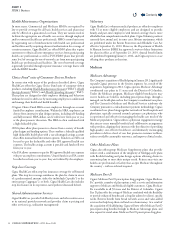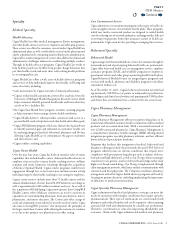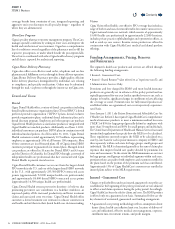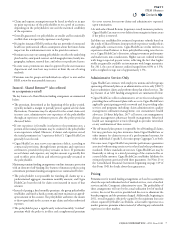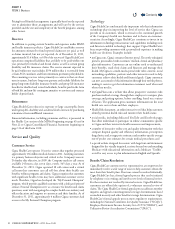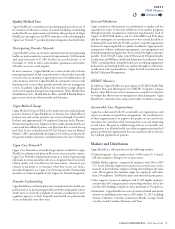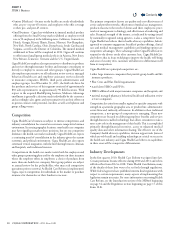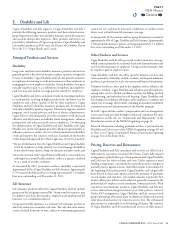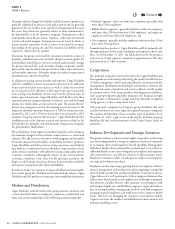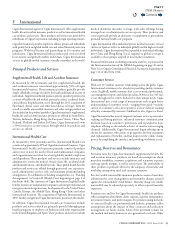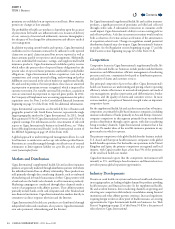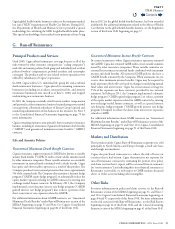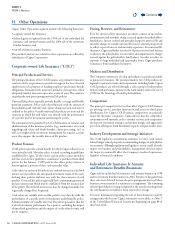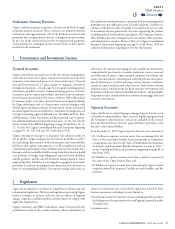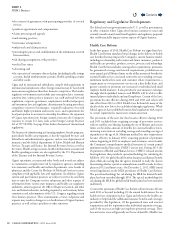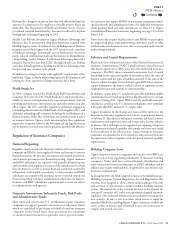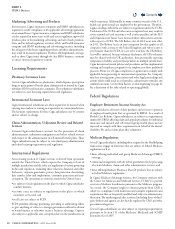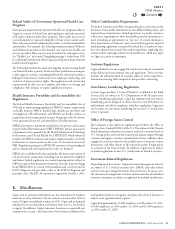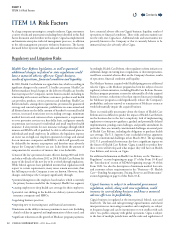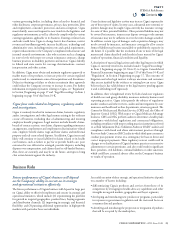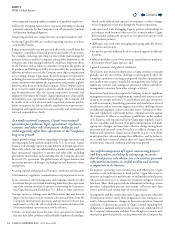Cigna 2011 Annual Report Download - page 36
Download and view the complete annual report
Please find page 36 of the 2011 Cigna annual report below. You can navigate through the pages in the report by either clicking on the pages listed below, or by using the keyword search tool below to find specific information within the annual report.
14 CIGNA CORPORATION2011 Form10K
PARTI
ITEM 1 Business
premiums are established on an experience-rated basis. Most contracts
permit rate changes at least annually.
e protability of health care products is dependent upon the accuracy
of projections for health care ination (unit cost, location of delivery
of care, currency of incurral and utilization), customer demographics,
the adequacy of fees charged for administration and eective medical
cost management.
In addition to paying current benets and expenses, Cigna International
establishes reserves of amounts estimated to be sucient to settle reported
claims not yet paid, claims incurred but not yet reported as well as
future amounts payable on experience-rated arrangements. Additionally,
for some individual life insurance, savings, and supplemental health
insurance products, Cigna International establishes policy reserves
which reect the present value of expected future obligations less the
present value of expected future premiums attributable to policyholder
obligations. Cigna International defers acquisition costs such as
commissions, and certain internal selling, underwriting and policy
fulllment costs incurred in the sales of multi-year supplemental health,
life, and accident products. For most products, these costs are amortized
in proportion to premium revenue recognized, which is impacted by
customer retention. For variable universal life products, acquisition
costs are amortized in proportion to expected gross prots. In 2012,
the Company will implement new accounting requirements for policy
acquisition costs. See Note2 to the Consolidated Financial Statements
beginning on page72 of the Form10-K for additional information.
Cigna International’s operations are diversied by line of business and
geographic spread of risk. South Korea, however, represents the single
largest geographic market for Cigna International. In 2011, South
Korea generated 31% of Cigna International’s revenues and 51% of its
segment earnings. For information on the concentration of risk with
respect to Cigna International’s business in South Korea, see “Other
Items Aecting International Results” in the International section of
the MD&A beginning on page49 of this Form10-K.
A global approach to underwriting risk management allows for each
local business to underwrite and accept risk withinspecied limits.
Retentionsarecentrally managedthroughcost eective use of external
reinsurance to limit segment liability on a per life, per risk, and per
event (catastrophe) basis.
Markets and Distribution
Cigna International’s supplemental health, life and accident insurance
products are generally marketed through distribution partners with whom
the individual insured has an anity relationship. ese products are
sold primarily through direct marketing channels, such as outbound
telemarketing and in-branch bancassurance (where Cigna partners with
a bank and uses the bank’s sales channels to sell its insurance products).
Marketing campaigns are conducted through these channels under a
variety of arrangements with anity partners. ese anity partners
primarily include banks, credit card companies and other nancial and
non-nancial institutions. Cigna International also markets directly to
consumers via direct response television and the Internet.
Cigna International’s health care products are distributed through
independent brokers and consultants, select partners, Cigna International’s
own sales personnel, telemarketing and the Internet.
For Cigna International’s supplemental health, life and accident insurance
products, a signicant portion of premiums are billed and collected
through credit cards. A substantial contraction in consumer credit
could impact Cigna International’s ability to retain existing policies
and sell new policies. A decline in customer retention would result in
both a reduction of revenue and an acceleration of the amortization
of acquisition related costs. Changes in regulation around permitted
distribution channels may also impact Cigna International’s business
or results. See the Regulation section beginning on page17 and the
Risk Factors section beginning on page22 of this Form10-K.
Competition
Competitive factors in Cigna International’s supplemental health, life
and accident and health care businesses include product and distribution
innovation and dierentiation, ecient management of marketing
processes and costs, commission levels paid to distribution partners,
and quality of claims and customer services.
e principal competitive factors that aect Cigna International’s
health care businesses are underwriting and pricing, relative operating
eciency, relative eectiveness in network development and medical
cost management, product innovation and dierentiation, broker
relations, and the quality of claims and customer service. In most
overseas markets, perception of nancial strength is also an important
competitive factor.
For the supplemental health, life and accident insurance line of business,
competitors are primarily locally based insurance companies, including
insurance subsidiaries of banks primarily in Asia and Europe. Insurance
company competitors in this segment primarily focus on traditional
product distribution through captive agents, with direct marketing
being secondary channels. Cigna International estimates that it has
less than 2% market share of the total life insurance premiums in any
given market in which it operates.
e primary competitors of the global health benets business include
U.S.-based and European health insurance companies with global
health benets operations. For the health care operations in the United
Kingdom and Spain, the primary competitors are regional and local
insurers, with Cigna’s market share at less than 5% of the premiums
of the total local health care market.
Cigna International expects that the competitive environment will
intensify as U.S. and Europe-based insurance and nancial services
providers pursue global expansion opportunities.
Industry Developments
Pressure on social health care systems and increased wealth and education
in emerging markets are leading to higher demand for products providing
health insurance and nancial security. In the supplemental health,
life and accident business, direct marketing channels are growing and
attracting new competitors while industry consolidation among nancial
institutions and other anity partners continues. Increased regulations
requiring foreign workers to show proof of health insurance are creating
opportunities for Cigna International’s health care businesses. See “Risk
Factors” beginning on page22 of this Form10-K for a discussion of
risks related to Cigna International.
Contents
Q


